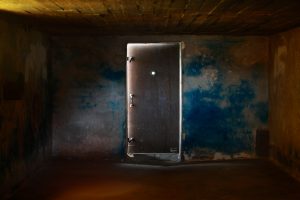On Friday, January 4, 2013, my Future, Beware! exhibit opened at the Osborn Gallery on the UNO campus. By the time it closed on Friday, February 22, 2013, thousands of visitors viewed its content, many of them taking home the accompanying book for continued reflection. The three lecture events that were held in conjunction with the exhibit were well attended and exposed many to new details about the Holocaust. The exhibit, which was commissioned and supported by the UNO History Department, was based on my March of the Living project, which I embarked on three years earlier. In that project and the book that followed it, I investigated the ways Jewish American teens perceive the subject of the Holocaust. As a Sabra1 growing up in Israel and a member of the “second generation,” many of my elders, from school teachers and administrators to neighborhood shop owners, to friends’ parents, including my father, were all Holocaust survivors.
 I grew up with a vivid view and direct access to these survivors, their behavior, their stories, their struggles, and their demons. That overstimulation experience was a matter of daily life for me growing up, and it instilled in me an understanding of the Holocaust as a deliberate and focused attempt at exnihilating Jewish people like myself from existence. The six million Jews that perished in the extermination facilities, the labor camps, and the death marches seemed to be the only victims of the Holocaust. There was little or no mention of the other five million or so Roma, Soviet POws, Poles, Jehova’s Witnesses, German political opponents, homosexuals, the physically and mentally handicapped, and others. WWII was a mere sideshow to this main event, The Holocaust.
I grew up with a vivid view and direct access to these survivors, their behavior, their stories, their struggles, and their demons. That overstimulation experience was a matter of daily life for me growing up, and it instilled in me an understanding of the Holocaust as a deliberate and focused attempt at exnihilating Jewish people like myself from existence. The six million Jews that perished in the extermination facilities, the labor camps, and the death marches seemed to be the only victims of the Holocaust. There was little or no mention of the other five million or so Roma, Soviet POws, Poles, Jehova’s Witnesses, German political opponents, homosexuals, the physically and mentally handicapped, and others. WWII was a mere sideshow to this main event, The Holocaust.
Years later, as an adult parent raising Jewish American kids, whose access to Holocaust survivors was far more limited than mine was, I wondered: can these kids appreciate the magnitude of this pivotal event in human history, or would it become just another line in the annals of history to them? I decided to join a March of the Living trip with a group of Jewish young adults nearing the end of their high school. Over the course of a week, we toured several locations in Poland that once were home to thriving Jewish communities, and visited several labor and death camps throughout the country. I immersed myself in the group, participated in all the activities while carrying my cameras taking pictures and notes. The experience was exhilarating and educational for me. Weeks later and back at my studio, I found the experiences of writing and editing the book based on those images and notes to be cathartic, and one that allowed me a better understanding of the people who were part of the Holocaust, the victims, the perpetrators, and the bystanders. It was no longer us versus them – it was everyone who happened to be caught in the grips of that era. All of them, despite who they were and what they did, were all humans.
Since the end of the Second World War and to this day, horrific ethnic cleansing crimes were perpetrated in every corner of the world. Syrian citizens were being gassed and slaughtered by the forces of their army during the same time Future, Beware! was being viewed at the Osborn Gallery. Since the end of WWII, there was hardly a time where no violent conflict was in motion, taking a human toll on the weak and defenseless. Condemning war atrocities and prosecuting their perpetrators is necessary for justice and accountability, but those crimes are the result of human behavior, which as horrible and vile as it may be, is still that – human behavior.
In my Future, Beware! artist statement, I observed that the triangular perpetrator-victims-bystander dynamic is akin to other struggles between people, where the only varying parts are the magnitude of the conflict and the means by which the sides take up with each other. From school fights to family feuds to civic and democratic disagreements to global conflicts, this triangular relationship is always found. Our involvement in each situation varies too; we have and will take any of the three positions and be them in every conflict we are part of, each time in a different role, depending on the situation and its components. There is no avoiding being a part of that. Even the bystander is part of a conflict.
Recognizing these human traits is pivotal. It gives each of us a tool to assess our standing and involvement in any situation early on in it, and make wiser decisions going forward. Those decisions and actions will immediately affect the conflict we are involved in and could save untold amounts of pain, suffering, misunderstanding, and agony later on. Given our history as the human race, it is part of the way we behave. We cannot completely extinguish the fires, but we can certainly lower the level of the flames.
1a Jewish person born in Israel (or before 1948 in Palestine)